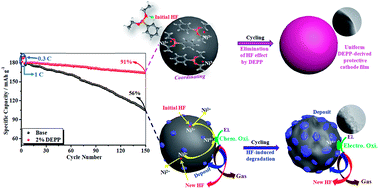Mechanism of cycling degradation and strategy to stabilize a nickel-rich cathode†
Abstract
A nickel-rich LiNi0.8Co0.15Al0.05O2 (NCA) cathode possesses high specific capacity and high discharge voltage, as the most promising cathode for high energy density lithium ion batteries, but suffers from serious cycling degradation. The present study revealed that the NCA cathode is stable with excellent cycling stability at voltages below 4.2 V, but suffers from serious degradation at voltages above 4.35 V. The characterization from SEM, TEM, XPS, FTIR, NMR, XRD and ICP as well as electrochemical measurements supported by theoretical calculations revealed that the trace of HF initially present in battery grade electrolytes likely induces the cycling stability degradation of the nickel-rich NCA cathode via accelerating the electrolyte decomposition. Our further research demonstrated that such cycling stability degradation can be eliminated through applying diethyl phenylphosphonite (DEPP) as an electrolyte additive, as DEPP is capable of shielding HF besides its ability to construct a protective cathode interphase, resulting in an excellent cycling stability of the nickel-rich NCA cathode.



 Please wait while we load your content...
Please wait while we load your content...